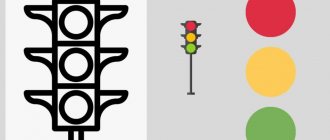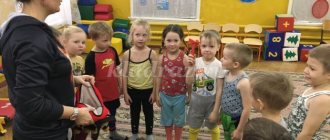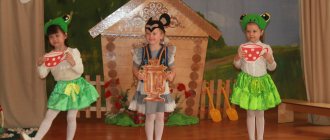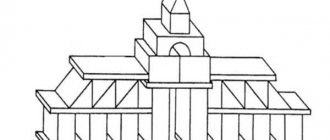Lesson summary: “Sand, stones, clay”
Lesson summary on the topic “Sand, clay, stone. Properties".
Goals:
Educational.
— to develop children’s cognitive and research activity in the process of forming ideas about the properties of sand, clay, and stone.
— teach how to compare materials, correctly name all the features in accordance with their properties, and use them in crafts.
- develop a “sense of time.” Introducing the hourglass.
Developmental.
- develop coherence of speech, visual attention, creative imagination.
— teach to observe, compare, analyze, classify, draw conclusions, make independent conclusions.
3. Educational
.
- formation of mutual assistance, goodwill, independence, initiative, responsibility, cooperation.
-instill in children accuracy and the ability to work with handouts.
Vocabulary work:
adjectives: hard, durable, free-flowing, dry, wet, viscous, binding
nouns: substance, property, magnifying glass.
Preliminary work:
observation of the properties of sand, clay, stone.
Examination of folk clay toys.
Manual and material:
-sand, clay and stones for each child, jars of water, plastic spoons, magnifying glasses, wooden sticks, aprons, lumps of wet clay.
GCD.
1. Introductory part.
Educator. Guys, we have a very interesting job today. It will take place in our children's “laboratory”. Let's imagine that we are "scientists". Who are scientists?
Children. People who study different subjects, conduct experiments, make discoveries, work with instruments
Educator. That's right, in our laboratory there are instruments that we have already worked with. And we, “scientists,” will conduct experiments, research, observations, and draw conclusions.
2. Main part.
Educator. You see natural material in front of you. Which?
Look and name.
Children. Clay, sand, stones.
Educator. Today we will compare materials in pairs - sand and stone, sand and clay, stone and clay. Let's look at and compare sand and stone. Touch the sand, play with it. What is he like, what can you say about him?
Children. The sand is dry and can be sprinkled.
Educator. To get a good look at it, take a magnifying glass and look through it. What do you see?
Children. Lots of small crumbs and grains of sand
Educator. That's right, sand is the smallest grains of sand, grains of destroyed stone. What kind of stone is it?
Children. It is hard, tough, smooth.
Educator. Now we will find out what is heavier, sand or stone. I will conduct an experiment, you watch carefully, and then conduct it yourself
I pour sand and stones into a jar of water and mix everything with a stick, watching how it settles to the bottom, what touched the bottom faster were the stones or the sand?
Just as you scientists yourself will now conduct the experiment, make observations and conclude what is heavier and what is lighter.
Take a jar of water, pour sand and stones into the jar, mix everything with a stick and see what you see, which touched the bottom faster, and why?
Children. Pebbles.
Educator. Why?
Children. Rocks are heavier than sand.
Educator. Now let's compare sand and clay.
Let's determine which allows water to pass through better. Take magnifying glasses, look at sand and clay, how do they differ from each other?
Children. Sand has many grains of sand, grains, but clay does not. It is dry, soft, like down.
Educator. Now I will conduct another experiment with sand and clay. You need to pour water into the glasses at the same time. Why at the same time? Our task is to determine whether sand or clay allows water to pass through faster: That’s why water needs to be poured at the same time. I take two jars with funnels, cover the holes in the funnels with a cotton pad, pour a spoonful of clay into the first funnel, and a spoonful of sand into the second funnel. Then, at the same time, I pour water from glasses into two jars up to the top onto the clay and sand, and see which jar fills the water faster.
Children. In a jar with sand.
Educator. Right, why? Who can answer?
Children. Sand allows water to pass through, but clay does not.
Educator. We made sure that sand allows water to pass through, but clay almost does not, since wet clay becomes viscous, sticky, it consists of tiny particles closely connected to each other, and it is good to sculpt from it. Now let's compare stone and clay. Let's clarify, what kind of stone?
Children. Heavy, hard, durable.
Educator. Guys, when clay dries, it turns into stone. See what happens when you press on a clay stone, what do you see?
Children. She fell apart.
Educator. And click on an ordinary stone. What happened to him?
Children. Nothing.
Educator. Why?
Children. Because the stone is durable and hard.
Educator. Children, you and I are convinced that the stone is hard, strong, durable. Because of its durability, stone is used in the construction of buildings. And many folk toys, crafts, whistles, and beautiful dishes are made from clay. And all this, sand, clay, and stone are called minerals. Who finds these minerals?
Children. Geologists.
Educator. Who are geologists?
Children. Geologists are people who look for minerals in the earth.
Physical education minute.
Educator. Now let’s imagine that we are “geologists” and will go in search of minerals. Maybe we'll get lucky today? (Children imitate movements, digging with a shovel, find clay.)
Educator. Guys, did you find something?
Children. Yes, clay.
Educator. What is clay?
Children. Mineral resource.
Educator. Why do we need clay, why is it useful?
Children. It is used to make toys, beautiful dishes, and is used in construction.
3. Summary of the lesson.
Well, today we were “scientists”, and “geologists”, and “researchers”; we learned about the properties of which minerals? (children's answers)
What have we learned about them, how are they useful? (children's answers)
Summary of GCD in the senior group “Sand, clay, earth”
Educator:
Right!
The rain is pouring - she drinks everything.
Everything else turns green and grows (earth)
Children's answers.
Educator:
Right!
Educator:
He opens the box and contains a glass of sand, clay, and earth.
Educator:
Guys, today we will explore sand, clay and earth. So, let's enter our laboratory and begin the research (the screen is pulled back, there are trays on the table with a glass of sand, a spoon, a mold for sand, a glass of water, a straw, napkins).
— At the beginning of our work, let’s remember the rules of behavior in our laboratory:
Don't try what you're experimenting with!
Do not pour sand into your eyes, do experiments carefully!
Listen carefully to the teacher!
Work together!
Wash your hands after experimenting!
— We will begin our research by studying sand. Look at it carefully.
1 experience:
"Where does sand come from"
Material:
stones, sheets of white paper, magnifying glass.
Progress of the experiment:
Take 2 stones and knock them against each other, rub them over a sheet of paper.
How do you think it's pouring in?
Take your magnifying glasses and look at this.
How did we get sand?
How does sand appear in nature?
Conclusion:
Wind and water destroy stones, resulting in sand.
— What is sand made of? (from grains of sand) What color? (light brown) Take sand with a spoon and pour into a plate. Does it flow well? What can be said about sand if it can be poured? What is he like? (Loose) Now take the tubes and gently blow on the sand, what happens?
Children's answers.
Educator:
The grains of sand move because they lie separate from each other.
What happens if you pour a little water into the sand? How do you think? (Children's answers) Where did the water go? (Children's answers).
Educator:
Can we say that the sand absorbed water and became wet? Can we say that wet sand is free-flowing? (No, loose only dry) Which sand is easier to build something from - wet or dry? (Children's answers).
Conclusion:
Guys, what have we learned about sand: sand consists of many small grains of sand, usually different. Sand (dry) is free-flowing, so the wind can easily move sand grains. If you wet it, the grains of sand stick together and stick to your hands and to each other.
- Now let’s move on to another table (the plates on the table are covered with napkins).
2 experience
: Raise the napkins! What do we see? How did you guess that it was clay? (Children's answers.)
- Look at it carefully. What color is it? (brown) Take it in your hands, remember! Is it easy to wrinkle? (children's answers)
- Let's pour some water into a bowl of clay and see what happens. Where did the water go? (It doesn't pass through clay well) How has the clay changed? (It has become plastic, soft, you can sculpt from it.) Guys, I also want to tell you that in Dagestan there is a village called Balkhar, where craftsmen make clay jugs and toys. (Showing jugs)
Game: “What is under our feet”
Goal: to consolidate the understanding that soil has different composition.
Progress: Children with models of earth, sand and clay, at the teacher’s signal, run up to their type of rock.
Game: “Guess which is better based on the characteristics of sand and clay for living organisms in the ground”
Procedure: children use a card with sand and clay to lay out living organisms living in the ground.
Game “We won’t say what we did, we’d better show it!”
Progress: Children show how they dug the earth, put it in a bag, how they looked through a magnifying glass, how they poured water, and so on.
Game: “Image of grains of sand, clay”
Progress: Each child stands separately. The wind blew, grains of sand moved and flew. Clay (in groups, holding hands, the wind blew in, they remained in place). Complicating the game: children are divided into two teams: one of them is grains of sand, the second is lumps of clay. The teacher uses a hairdryer or fan to imitate the wind, and the teams behave differently.
Game: “Screen of sensations”
Purpose: to determine the soil by touch: clay, sand, earth.
Progress: a screen of sensations, sand, clay, earth, stones, and other objects are offered. Children must determine what kind of object it is. Who guessed everything correctly? He won.
Sand game
Purpose: To consolidate the characteristics of sand, to determine the properties of this substance: sand. appear in everyday life.
Material: sand.
Procedure: dissolve in water and settle. Pour from different volumes.
Weigh dry and wet sand. Sift the sand between your fingers using a sieve. Examine under a magnifying glass. Transfer sand using various measures. Color the sand by rubbing it with colored crayons. Fill transparent containers with multi-colored layers of sand. Drill holes in the sand with water. Look for “secrets” in the sand, make an hourglass, mix sand with other bulk substances. Heat the sand under a lamp.
Game “If I were...”
Purpose: to help consolidate ideas about the properties of sand and clay obtained during experimentation.
Material: photographs depicting the inhabitants of the sandy desert.
Progress: The teacher invites the children to look at photographs depicting the inhabitants of the sandy desert. Each of them chooses the animal that he likes most. At a magical signal from an adult, children turn into these animals and tell about themselves “If I were a lizard and lived in the desert, I would...”. (how he hid, how he ate, how he ran, etc.)
Ball game "Living - Nonliving"
Goal: consolidation of knowledge about living and inanimate nature.
Move: the teacher throws the ball to the child, if he names an object of living nature, the child catches the ball, if it is inanimate, he hits it.
Game "Guess it"
Goal: consolidate knowledge about living and inanimate nature, develop memory and ingenuity.
Progress: one of the children conceives an object of living or inanimate nature and describes it. The task of the other participants in the game is what or who we are talking about, and explain why they classified it as living or inanimate nature.
Complication: children are divided into 2 teams. One depicts a plant or animal with its movements, the other - stone, sand, sun. Participants in the game guess who or what they are talking about.
Didactic game “What from what”
Purpose: to help consolidate ideas about the properties of sand and clay obtained during experimentation.
Material: clay, sand, pottery, glass and ceramic plates, vases.
Progress: children look at all the objects and tell what they are made of - sand or clay? Why do they think this? If they were ancient people, what would they use to make dishes from?
Introduction to sand and clay (lesson summary)
Lesson notes on experimentation.
"Introduction to sand and clay."
Software tasks:
1.
Educational:
Introduce children to the characteristics of sand and clay, compare how they differ, determine how the properties of these substances manifest themselves in everyday life (a combination of experimentation and observation).
2.
Developmental:
develop children's knowledge, skills and abilities in experimenting with sand and clay.
3.
Educational:
to cultivate a feeling of love for the world around us.
Materials and equipment:
Cups or other containers with sand and clay for each child (for ease of work, you can stick yellow circles on cups with sand, and brown circles on cups with clay); three-liter jar with a hose and sand; cups of water, sheets of paper, spoons, magnifying glasses, sticks.
Progress of the lesson.
Educator:
Guys, I received a package from a fairy-tale prince. Something bad happened to him; an evil wizard stole his princess. The prince will be able to free her if he builds a strong, reliable and beautiful castle. Only one of two types of material can be used for construction. The prince asks us to help choose the material. (Takes out bags of clay and sand from the parcel).
Educator:
- What is this? (sand and clay).
— The wizard asked a difficult task. The lock must be strong, not crumble, and not let water through when it rains. And the material for construction must mold well. What material do you think would be better?
Educator:
Let's see a picture of the castle. What is it made of? (brick). What do you think bricks can be made from: sand or clay? How can I check?
Do you know what people who do experiments are called? They are called researchers. Do you want to feel like an explorer?
Children:
Yes!
Educator:
Dear researchers! I invite you to the scientific laboratory, where we will conduct experiments with sand and clay, take your seats.
You need to work with sand and clay carefully so as not to get it in your mouth or eyes.
Young researchers are ready, so let’s get started.
Experience 1.
Take a cup of sand and carefully pour some sand onto a piece of paper. Is it easy for sand to fall? (Easily). Now let's try to pour clay out of the glass. What is easier to pour out - sand or clay? (Sand). That’s why they say that sand is free-flowing. The clay sticks together in lumps and cannot be poured out of the cup so easily.
Conclusion:
sand is loose, unlike clay.
Experience 2.
Let's use a magnifying glass to take a close look at what sand is made of (grains of sand). What do grains of sand look like? (they are very small, round, translucent (or white, yellow, these are tiny pebbles). Are the grains of sand similar to one another? How are they similar, how are they different? Examine a lump of clay in the same way. Are the same grains of sand visible in the clay? In the sand Each grain of sand lies separately, it does not stick to its “neighbors.” And in clay there are sticky, very small particles that form lumps. Children, is clay in some way similar to plasticine?
Conclusion:
sand consists of grains of sand that do not stick to each other, and clay is made of small particles that seem to hold hands tightly and stick to each other.
Experience 3.
Children, look at the jar of sand and clay in my hands. Take a tube and blow into a jar of sand and clay, see what happens to the grains of sand? (They move easily and deflate). What happens to lumps of clay? Can pieces of clay move as quickly and easily as grains of sand? (No, they deflate more difficult or do not move at all).
Conclusion:
grains of sand are easily blown away and run away from the wind, but stuck together particles of clay do not.
Well, guys, are you tired? Let's take a little rest.
After the experiments, the game “Sand and Clay” is played.
The audio recording “The Sound of the Wind” is turned on.
1
Children, will you be grains of sand? (each of you stands separately, without touching each other). The wind blew - what will happen to the grains of sand? (children are running).
2
Children, you will pretend to be particles of clay (you will stand in groups, holding hands). The wind blew - what happens to the pieces of clay? They remained where they were. If the wind is strong, the lumps of clay move slowly (children move slowly in groups, but do not unclench their hands).
3
Children divide into two teams: one team - grains of sand, the other - lumps of clay. The wind is blowing, children move around the group in different ways.
Well done! Now let’s sit back at the tables and continue our research.
Experience 4.
Children, let's carefully pour some water into a glass of sand. Touch the sand, what has it become? (damp, wet). Where did the water go? (she climbed into the sand and settled comfortably between the grains of sand). Now pour water into the glass with clay. Watch how the water is absorbed: quickly or slowly? (slowly, slower than in sand, some of the water remains on top).
Conclusion:
sand absorbs water, but clay does not.
Experience 5.
What breaks easier?
Children try to break bricks with their fingers. What happened to the sand bricks? Scattered. Do the clay ones crumble?
Conclusion: sand bricks are weak and easily fall apart, but clay bricks are strong and difficult to break.
“And for strength, clay figurines are fired in special ovens, after which they become strong and hard.
Lesson Analysis:
So, which bricks will protect better from rain: sand or clay? Why? That's right, sand bricks will allow water to pass through, but clay bricks will not.
Well done!
- What do you think now is better for building a castle? Why? What type of clay should be used for making bricks: dry or wet? What will happen to the castle when it rains if the bricks are sand? Well done my young researchers, you worked very well today. I think the prince will be glad of our help. Let's send him the necessary material. (put a bag of clay in the parcel.





